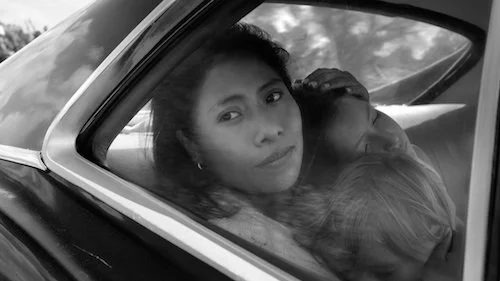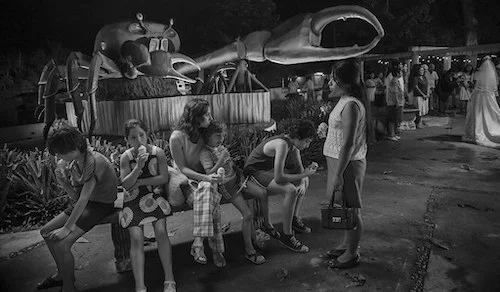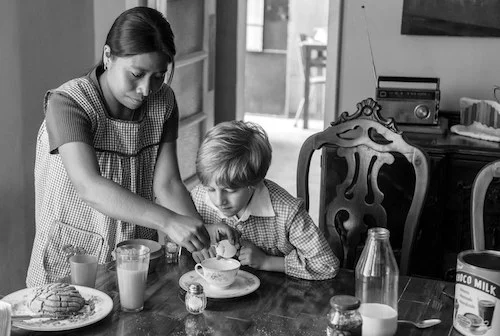Roma
From the earliest days of cinema, we can find something that film dissector Tom Gunning has crowned the “cinema of attractions”; this essentially refers to how the dawn of cinema was used to engulf audiences within a self-contained, celluloid world. We are well into the digital age — we’re covering a Netflix original, after all — and this term still applies. You can see how blockbuster action flicks bring you into a war zone you would usually avoid. Thrillers place you amongst dangerous schemes for a little while. Comedy allows you to watch shenanigans not at your own expense. However, the barest of basics when it came to this idea of a “cinema of attractions” was to see life as we know it in a new way. The earliest films ever were shorts that people were just thankful even existed. There is footage of workers leaving a factory after their shift, a train arriving at a station, and — gasp — a kiss that lasts around nine seconds. These were some of the earliest examples of films. This was our life displayed in a new way. We could experience it all with new eyes (or a lens, appropriately).
Then there is Roma, possibly the best example of this ideology to have come out in many years. Alfonso Cuarón is clearly a lover of cinema as a language, hence why he has tried to disobey its laws in the most mainstream ways possible. Gravity was far from an experimental film, but it sure tried to push ground with its long takes (not a foreign concept when you’re talking about Cuarón by any stretch, see Children of Men for starters). He is an established enough filmmaker that he could put out a film like Roma if he wanted (this was a dream project of his that he shelved for over a decade). This was Cuarón’s world though; having grown up in Mexico with help surrounding him in his established household. A number of aspects of Roma are autobiographical, whether it happened to the cleaners of his house, or if he included furniture and antiques from his actual house as props.
Yalitza Aparicio as Cleo.
There is so much dedication here, because Cuarón wanted to represent it all. His youth. The political climate of '70s Mexico. The difficulties the women in his life had to deal with. The pushing through devastation that he experienced in a variety of ways. Roma takes place in the Mexican district of the same name, but it is also the word “amor” spelled backwards, as if the key to getting through it all is to let love stay in the back of your mind (even during the most hateful of times). Cleo — the anchor of the entire film — has to let her heart and willpower guide her, because she endures far too much in this film to just shrug it all off without going insane. The worst part is none of this would have even been heard if it wasn’t for a film like Roma. Life continues, and it zips right past the house cleaners in privileged areas. This was just a year in Cleo’s life despite what happens. Yet, we get to experience it all first hand. Cleo’s story matters to us, and all of the stories of everyone should always matter. That’s one of the countless reasons why Roma is so special. This truly is a cinema of attractions for unheard voices. You don’t just get told about Cleo’s tumultuous year: you live it entirely.
This is thanks to the stunning cinematography (by Cuarón himself) and sound work in the film. Sure, this is conveniently a film that is streaming on Netflix, yet it absolutely demanded to be seen in a theatre in 70mm with Dolby Atmos sound. From the very first image of suds-cloaked water coasting up a dirty tiled driveway, you know this is going to be a hypnotic film. Then you hear the water cascading down the passageway, and understand that even the sound will be ever so precise. That’s just how it starts. Sound and vision are more important than usual, as that is the primary story telling device here. It truly is film stripped back to its roots. You aren’t told there is political turmoil. You can see it with the systemic marches down the streets, the many posters decorating the walls, and the tensions between strangers.
A hand picked shot that showcases one of my personal favourite film images (perhaps of all time).
Just look at these images included in this review. All of these came from the film (yes, including the still used for the poster). None of these are promotional shots orchestrated to sell Roma. All of these are split seconds taken from the film, and they are not doctored in any sort of way (outside of the poster). This is a living photo album, with the sounds flowing through your ears like a powerful memory. This is exactly what motion pictures did in the first place: they showed other people something you experienced (if you made the film, that is). All of this is to experience Cleo’s year, and you truly are a part of the film in a way that most mainstream works just cannot fulfil in the same way.
And what a year Cleo has had. Cleo is perfectly played by newcomer Yalitza Aparicio, with the kind of rawness that the Italian neorealists found in strangers off the streets. Once again, this goes back to the idea of cinema of attractions from where it once was. Sometimes, a high profile performer can’t wring out a scene of all of its essential extracts quite the same way that a non-performer can. Aparicio doesn’t know how to act, so she instead lives every scene. She doesn’t overstay her welcome in neutral scenes (there is no need to put on a show). She never tries to steal the scene during traumatic moments. Aparicio literally just enacts each and every moment as if she was living them; in a film like Roma, you certainly cannot have a better motive. This enhances everything, from the imagery to the sound usage. You are there, and you are beside a very real Cleo that is having some of the roughest moments of her life.
An early scene in Roma.
Titanic doesn’t even begin to explain it. For such a glowing review, I will say that not much happens in Roma. However, everything happens in Roma. It’s all about fixating on all of the glorious details. However, when it comes to the plot, there are only a handful of pivotal moments. When they hit, they feel like a kick right to the face. As you are living this film, these situations come at you without warning. There isn’t any use of non-diegetic sound in Roma (music that sits on top of the film but is not coming from any audible source from within a scene: think “Miserlou” at the beginning of Pulp Fiction for an easy example). Any use of music is cleverly integrated into the film (a record being played, a garage band performing, a car radio speeding past). Therefore, there aren’t any cues that prepare you for any situation. Disaster just happens, and it occurs whenever it decides to. These scenes are almost nauseating, because you cannot stop them in any way, shape or form; you are a bystander this entire film, and these scenes are no exception.
Then there is the subplot that references the family Cleo works for. This family is experiencing its own hardships, as the father of the house decides not to return after a business trip. You never get a sense that this storyline is trivial compared to Cleo’s issues or anything, but you do sense a priority taking place. You witness this hardship with a side glance, as if you can understand that all of this is bad but can only take so much right now (naturally, like Cleo). You can only offer to be a shoulder to cry on. There is no real competition between classes here, but you can see what kinds of burdens different walks of life may be experiencing.
Cleo taking care of one of the children.
It can’t be said enough how much like real life Roma is. It truly is one of the most tangible examples of life imitating art that can be found in any cinematic piece this millennium. It’s no hyperbole when I say that a film like Roma occurs once in an era. This is beyond just a good story, or some nice acting. This is a new interpretation of the very foundations of what cinema once was. This is a shifting tide by a filmmaker that felt he played by the current rules long enough. This is an understanding of film as a moving set of photographs. This is the reminder that sound is also important in this medium. This is a push for revisionist ideas (like casting non actors). Roma is one of the strongest love letters to cinema there ever was. This is a once-in-a-lifetime film that is so far ahead of the pack, it might be unfair to even discuss “best of the decade” lists right now. Its pacing might not astound everyone, but Roma demands to be seen just so you can experience a legitimate masterpiece when it was released to the world (and not decades later when it is referred to as a classic, as it absolutely will be).
Andreas Babiolakis has a Masters degree in Film and Photography Preservation and Collections management from Ryerson University, as well as a Bachelors degree in Cinema Studies from York University. His favourite times of year are the Criterion Collection flash sales and the annual Toronto International Film Festival.









